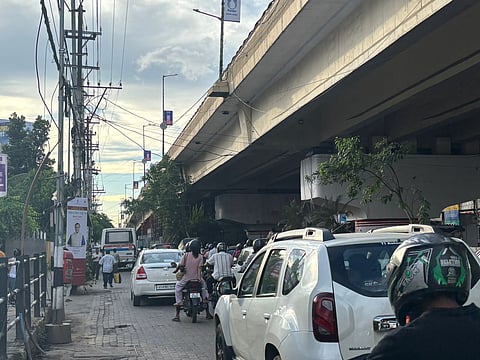
- Home
- Live Blog
- Breaking News
- Top Headlines
- Cities
- NE News
- Sentinel Media
- Sports
- Education
- Jobs

Staff reporter
Guwahati: With the newly-constructed bridge near the Six Mile junction thrown open to the public on Sunday, Guwahati’s commuters are hoping for some relief from the chronic congestion that has gripped the area for months. But even as vehicles began using the bridge, traffic chaos on the adjoining roads remained largely unchanged, leaving many residents asking: Will this really solve the problem?
The Jayanagar–Six Mile stretch is a major arterial corridor connecting key localities like Beltola, Rukminigaon, and Wireless. In recent weeks, it has been plagued by gridlock, poor enforcement, and disorganized public transport movement — issues that one bridge alone may not be able to solve.
“The new bridge has finally opened, but will it really change anything?” asked a daily commuter from Rukminigaon. “Unless traffic rules are enforced properly and buses are disciplined, the bridge won’t matter much. What we need is proper traffic management.”
A major contributing factor to the congestion has been the rerouting of heavy vehicles and city buses onto the narrow service lanes during the flyover construction. Several city buses continued to halt indiscriminately in the middle of the road, particularly near GNRC Hospital. A newly created bus stop on the already congested service lane has worsened the bottlenecks during peak hours.
Making matters worse, traffic signals at the crucial VIP Road–Panjabari Road junction remain non-functional. The absence of traffic police between 12 noon and 3 PM has turned this busy stretch into a free-for-all zone, where wrong-side driving, illegal parking, and jaywalking are rampant.
In such a high-traffic corridor, residents and commuters strongly feel that a higher deployment of traffic personnel is urgently needed. “This area sees thousands of vehicles every hour. Why are there only two or three traffic police at a time and that too only in the morning or late evening?” questioned a local shopkeeper near the junction. Without a consistent and visible presence of enforcement officers, the traffic remains unmanageable even with new infrastructure in place.
Adding to the disarray are remnants of the flyover construction — barricades, debris, and materials left along the roadsides, which continue to block vital carriageways and limit traffic movement. Despite the new bridge becoming operational, these leftover elements signal incomplete planning and poor execution.
To complicate matters further, a jurisdictional conflict between Dispur and Basistha police stations has left this stretch without effective monitoring. “That section doesn’t fall under our jurisdiction,” was the opt-repeated reply from both stations when contacted, underscoring the administrative vacuum that commuters face daily.
Urban planners and residents are now calling for immediate and coordinated measures, including complete clearance of construction debris from roadsides, restoration of traffic signals, designation of bus stops in wider, safer areas, increased deployment of traffic personnel during peak hours, strict enforcement of traffic laws, defined vending zones to keep footpaths clear and clarification on enforcement jurisdiction.
Until these basic but critical steps are taken, the new bridge — while welcome — may do little more than offer cosmetic relief.
Also Read: Public art installation at Six-Mile bus stop brings bird habitat
Also Watch: